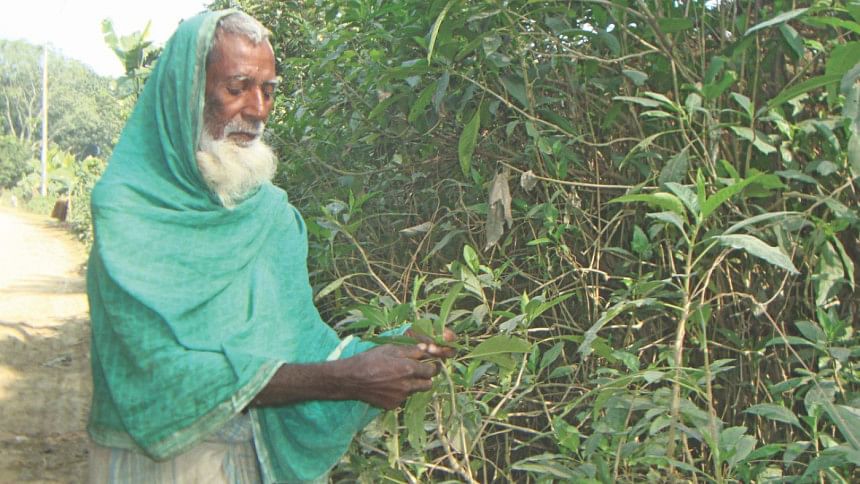Medicinal adulsa helping farmers

Many know that winter feeling: rugged up in a blanket feeling sorry for oneself, struggling to overcome a cough or cold. While modern science is yet to discover a definitive cure for the fast-mutating viruses that are often behind such basic ailments, an endemic treatment is at hand.
In Mostabapur village of Jhenidah's Kaliganj upazila the plant known in English as either adulsa or Malabar nut, and locally called bashak leaves, is producing extra profits for farmers.
“I started farming adulsa about seven years ago,” says Mostabapur inhabitant Shahidul Islam. “I planted the crop on 20 decimals. It's a medicinal plant that's also used in fencing.”
“The representatives of medical companies visit our village in search of adulsa,” says neighbouring farmer Moksed Khan. “Two years ago I planted it on 15 decimals. One year later I earned Tk 3,000 from the first harvest of the leaves.”
There are currently 12 farmers in Mostabapur who dabble in adulsa, a plant that can be grown along the roadside or on otherwise vacant or fallow land. While the shrub is nondescript for most of the year, in flowering season it produces attractive white blooms. “Adulsa enhances the beauty of household yard,” notes Shahidul.
He estimates the small-scale production of the crop already brings around Tk 10,000 into the village per annum. Adulsa is likewise grown in several neighbouring villages, with overall production on the rise.
A plant native to Bangladesh, its curative properties are hardly a mystery to Mostabapur villagers. “The leaves are very useful for patients,” says 80-year-old Abbas Mondol. “It's good for cough and cold sufferers.”
“I collect the leaves and squeeze out the juice for my children to drink when they get sick in winter,” says widow Amena Khatun. “The leaves are a tonic suitable for poor and struggling families like ours, since we can't afford to buy medicines. Adulsa helps the children recover.”
Japan-based organisation Hunger Free World together with the Bangladesh Forest Research Institute are encouraging adulsa cultivation in the area.
“People all across the country consume adulsa as an antidote to coughs and colds, not only in winter but year-round,” advises an official of the research institute. “People can earn good money from growing it.”
Once the quality of the locally produced adulsa is properly tested, plans are afoot to further increase public awareness of its medicinal quality. “We will arrange training for the farmers,” says SM Shahin Hossain, a programme officer with Hunger Free World. “Pharmaceutical companies including Acme and Square buy adulsa. There is demand for the leaves.”
“The nationwide demand is significant,” agrees research institute divisional officer Md Rafikul Islam. “Currently only 10 percent of adulsa demand is met with domestically-grown leaves, with the remaining 90 percent imported from India.”
“With greater awareness,” he continues, “local farmers can benefit from adulsa cultivation as the soil and weather in Kaliganj upazila are suitable.” Commercial crops are also being grown in parts of North Bengal.

 For all latest news, follow The Daily Star's Google News channel.
For all latest news, follow The Daily Star's Google News channel. 



Comments